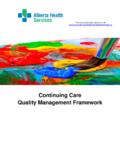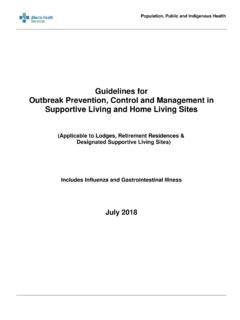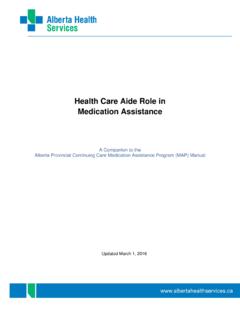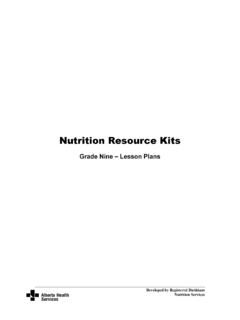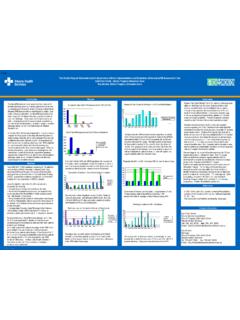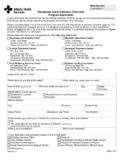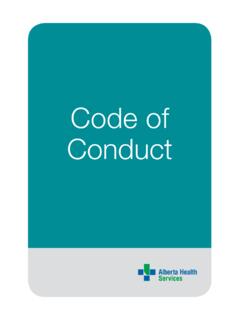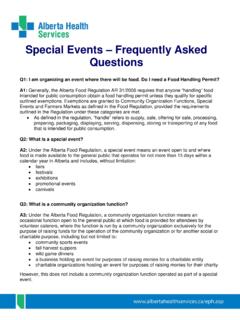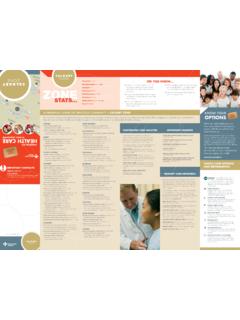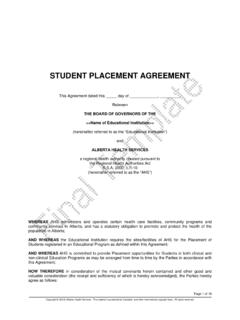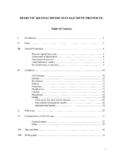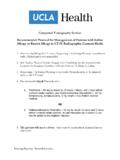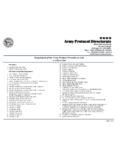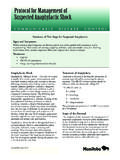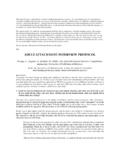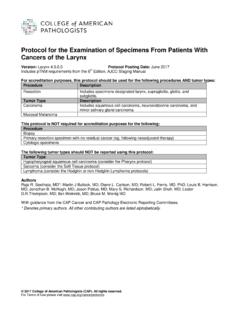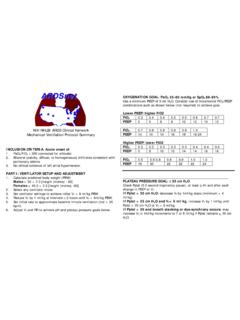Transcription of Bedbug Management Protocols for Healthcare …
1 Environmental Public health and Infection Prevention and Control, Alberta health Services June 4, 2013 Page 1 Bedbug Management Protocols for health care Workers Environmental Public health and Infection Prevention and Control, Alberta health Services June 4, 2013 Page 2 Bedbug FACTOIDS: Bedbugs are not known to transmit any human communicable diseases. Adult bugs are wingless, oval, flat, reddish brown insects, about the size of an apple seed. (this picture is magnified) Bedbugs that have recently fed are brighter red and engorged, they look less flat and less brown. They prefer to feed on human blood, but will feed off of other mammals ( dogs and cats). Bedbugs do not jump or fly, but they do crawl. Usually they are spread by belongings or clothes.
2 Bites usually cause small, hard, white welts that are often itchy. Reactions to Bedbug bites may result in bumps or welts that resemble mosquito or other insect bites. Not everyone will experience a reaction so history and other physical evidence must be considered. Evidence of feeding and excreta (small blood stains and/or dark spots) can be found on sheets and mattresses. Heavy infestations are often accompanied by a sweet, sickly smell. Bedbugs dislike light and movement and are rarely seen during the day or on a person s body or clothing. They like to hide in the seams of mattresses and covers, but may also be present on items that are in extended/frequent contact with the individual ( wheelchairs and cushions). They are attracted to warmth and may be found hiding around any mechanical device that produces heat ( O2 compressors, home dialysis units, home electronics).
3 They may be also present in crevices in nearby furniture, walls or fixtures. Ordinary household insecticides and disinfectants are not effective in eradicating an infestation. The service of a licensed pest control operator is required. Environmental Public health and Infection Prevention and Control, Alberta health Services June 4, 2013 Page 3 General Prevention in All health care Settings PERSONAL or CLIENT MEASURES: Whenever possible, ask that clients/patients DO NOT bring unnecessary equipment or personal belongings into health care settings. If personal furnishings and belongings are brought into assisted living sites: these items should be assessed when the resident first moves in. Residential spaces should be inspected on a regular basis.
4 For specific information on inspecting personal items contact Environmental Public health . Healthcare workers should not bring unnecessary equipment, supplies or personal belongings into the treatment setting. Be alert for bedbugs on patient clothing or belongings. If bedbugs are suspected or seen, refer to the Response protocol for the type of health care area for reporting and further actions: OUTPATIENT CLINICS OR EMERGENCY DEPARTMENTS (SEE PAGE 4) ACUTE care INPATIENT, CONTINUING care FACILITY and CORRECTIONS SETTINGS (SEE PAGE 5) PRIVATE CLIENT RESIDENCE (SEE PAGE 6). ENVIRONMENTAL or FACILITY MEASURES: Eliminate sites where bedbugs hide to prevent infestation and transmission: Remove clutter. Healthcare facilities should seal cracks and crevices in patient/resident rooms and common spaces ( lounges).
5 This is especially important to prevent bugs from migrating through walls and where ever a pipe or wiring goes through a wall or floor ( heated ducts, plumbing pipe, TV cables, medical gasses). Laundry handling practises: limit agitation/shaking of laundry, clear separation of clean and soiled laundry, and using hot wash and hot dry cycles whenever the fabrics will tolerate it. Dry cleaning is also effective in killing the bugs and may be an alternative for more delicate fabrics. Periodically vacuum and/or steam vacuum areas prone to bedbugs. If evidence of infestation present, place vacuum bag in a sealed plastic bag; discard the plastic bag immediately in an OUTSIDE trash bin. Inspect for bedbugs routinely: Daily monitoring during housekeeping activities; AND Periodically inspecting resident spaces specifically for bedbugs.
6 Consider using sticky traps or pest control glue boards placed near beds and adjacent walls to detect the presence of bedbugs. Traps should be checked frequently. If bedbugs are suspected or seen, refer to the Response Protocols for reporting and appropriate actions. OUTPATIENT CLINICS OR EMERGENCY DEPARTMENTS (SEE PAGE 4) ACUTE care INPATIENT, CONTINUING care FACILITY and CORRECTIONS SETTINGS (SEE PAGE 5) PRIVATE CLIENT RESIDENCE (SEE PAGE 6) Environmental Public health and Infection Prevention and Control, Alberta health Services June 4, 2013 Page 4 Response protocol OUTPATIENT CLINICS OR EMERGENCY DEPARTMENTS Respond promptly and sympathetically to patients and family members reporting Bedbug problems. Provide education and resources available from Alberta health Services at Healthcare workers should only wear personal protective equipment (PPE) as needed for Routine Practice (protection against contact with body fluids/substances during care activities).
7 Additional PPE is not recommended ( gowns and gloves for casual contact). Shoe covers and hair coverings are not recommended. If the client/patient has visible evidence of live bugs AND is going to be in the clinic for greater than one hour or will be disrobing, contain all patient belongings in plastic bags; double-bag and seal each bag for the duration of the visit. If possible have the client change into facility-supplied clothing (gown or scrubs) and seal the client s clothing in a plastic bag with their other belongings. Inspect room or treatment area for bedbugs following the client/patient visit. Take the room/treatment bay out of service until inspected and cleaned by Environmental Services. If bugs are found, collect specimens for positive identification by a qualified professional.
8 Specimens should be placed in a sealed container in rubbing alcohol to prevent escape. Alcohol will kill adult insects. Destroy other bugs by mechanical force. Inspect crevices of anything brought into the room/treatment area, including equipment, bags, shoes, and clothing, BEFORE leaving the area. Cleaning and disinfection (following room/treatment area inspection): Remove bed linens and washable furnishings with minimal agitation. Contain in designated plastic laundry bag(s); double-bag and seal each bag. If bugs are detected, close the room/area until it has been treated and cleared by a licensed pest control operator. If bugs are not detected, or following treatment by the pest control operator, clean area as per usual.
9 Additional disinfectants or pesticides are not recommended. Report incident to Manager, the site Environmental Services provider and to site Administration. Environmental Services will communicate when room/treatment bay is ready to return to service. If you believe that you are experiencing a work place related or acquired Bedbug infestation of your home or belongings notify your Manager and contact Workplace health and Safety through Workplace Incident Reporting System. If bugs are found, collect specimens for positive identification by a qualified professional. Specimens should be placed in a sealed container in rubbing alcohol to prevent escape. Alcohol will kill adult insects. Destroy other bugs by mechanical force. Environmental Public health and Infection Prevention and Control, Alberta health Services June 4, 2013 Page 5 Response protocol ACUTE care INPATIENT, CONTINUING care FACILITY and CORRECTIONS SETTINGS Respond promptly and sympathetically to patients and family members reporting Bedbug problems.
10 Provide education and resources available from Alberta health Services at Isolate patient/resident in a designated room or area. Report incident to Manager, the site Environmental Services provider and to site Administration. Take the room out of service for other patients/residents until inspected and cleaned by the site Environmental Services provider and/or a licensed pest control operator. Healthcare workers should only wear PPE as needed for Routine Practice (protection against contact with body fluids/substances during care activities). Additional PPE is not recommended ( gowns and gloves for casual contact). Shoe covers and hair coverings are not recommended. Have the patient/resident change into examination gown.
